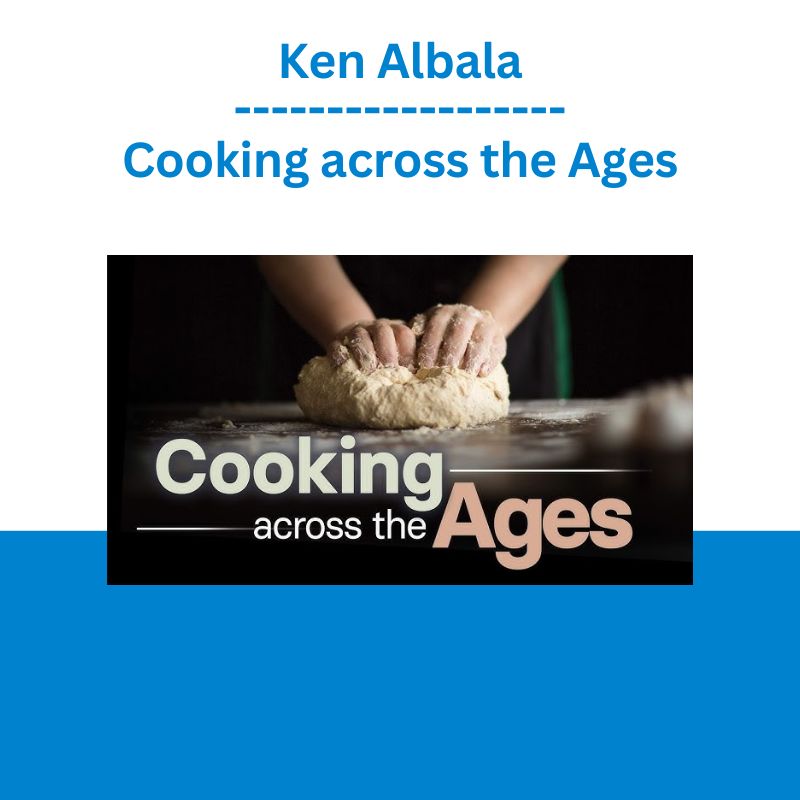*** Proof of Product ***
Exploring the Essential Features of “Ken Albala – Cooking across the Ages”
Cooking across the Ages
An aspic is a gelatin dish made with a meat stock that was served as a main course. And that’s not even close to the weirdest thing people have done with food.
LECTURE (24)
01:Understanding Culture through Cooking
What can you learn about different cultural groups of people through the lens of their cookbooks? A lot, as Professor Ken Albala illustrates by looking at two chicken recipes 200 years and a continent apart. Learn to cook a recipe from the 1748 French cookbook Le Nouveau Cuisinier Royal et Bourgeois, and another from The Can-Opener Cookbook of 1953.
02:Ancient Rome: Cooking with Apicius
Are the recipes in De re coquinaria—the oldest complete recipe book in the Western tradition—bizarre and disgusting, or do they reflect a time of elegance and luxury? Historians have expressed a gamut of opinions. As you explore its sala cattabia, minutal of apricots, and botellum, you might be surprised to find three delicious, and even somewhat familiar, dishes.
03:Imperial China: Soybeans and Dumplings
Examine the Chinese Wei dynasty’s Qi Min Yao Shu, an encyclopedic manual containing “essential techniques to benefit the people” and learn about Chinese agricultural practices going back to antiquity. Explore the fermentation practices of the time, using both bacteria and mold, and follow a scaled-down recipe to create an intensely flavored fermented black bean dish.
04:Medieval Egypt: Chickpeas and Phyllo Dough
From 14th-century Egypt, explore recipes that reflect the interchange between the many cultures of the Eastern Mediterranean of the time—Alexandria, Venice, and Constantinople, just to name a few. Learn to make the sweet Byzantine specialty known as himmas kassa, and a super light and flaky phyllo dough stretched to the size of a table, just as Professor Albala remembers his grandmother doing.
05:Feast like a Viking with Meat and Beer
Explore the oldest-known cookbook in Medieval Europe, the 13th century’s Libellus de arte coquinaria. With its terse recipes of meat, fowl, fish, and sauces, it seemed to be written for a noble audience, not the common cook. Learn to make “hunter-style” fish pie with animal bones—and beer, much safer than drinking water at the time.
06:Medieval France’s Touch for Sugar and Spice
Meet the first celebrity chef—Guillaume Tirel, known as Taillevent—who served in the 14th century as master chef in the French imperial courts. His Le Viandier was not an introduction to cooking but served as an aid to help people remember how to cook the classics. Dive into his recipe for a polysavory white stew of capons, along with individual tarts with banners for your guests.
07:Renaissance Italy’s Sweets and Pasta
Explore the earliest printed cookbook, composed in Italy in the early 15th century and printed around 1470—making it one of the first generation of books in print on any subject. Learn to create its blancmanger, a combination of capon breast, white flour, rosewater, sugar, and almond milk that still exists today in Turkish cuisine. And discover how to make pasta by feel and texture, no measurements allowed.
08:Crafting Aphrodisiacs from the Renaissance
Renaissance medicine promoted the idea that some foods made you hot, some cold, some promoted healthy libido and reproduction, and some not. Explore the 1560 cookbook of Domenico Romoli, which combined recipes with medical advice. Learn to make his chickpea fritters, zeppole, and sofrito of chopped beef.
09:Aztec Tortillas and Chocolate
While no written recipes exist from Aztec culture—either because they were intentionally destroyed by colonial invaders or accidentally by the passage of time—we can infer what they ate and cooked from other literature that did survive, and by studying the ecology of the area. Master the secrets of an Aztec specialty: drinking chocolate poured from on high to create a special froth, as well as their turkey tamales.
10:Papal Rome: Meat Rolls and Eggplant
Explore the encyclopedic wonders of the Opera, a 1570 cookbook by Bartolomeo Scappi. Unusual for its time, Opera was a cookbook written specifically to teach cooking. With directions and recipes from the Late Renaissance style, and using lavish and contrasting flavors, you will create delicious meat rolls, salami, and an eggplant dish.
11:Dining with Don Quixote in Imperial Spain
Spain became a gastronomic model for much of Europe in the 17th century, with its culinary influence becoming widespread even after suffering military defeat. As you cook its olla podrida, discover the riot of flavors—lamb, beef, pig’s feet, chestnuts, turnips, and more—in this “rotten pot” that became popular throughout Europe.
12:Portugal and Japan: Cakes and Katsuobushi
Explore the fascinating decades of exchange between Portugal and Japan in the 16th century—before Japan turned to cultural isolation—and discover which Portuguese foods are still part of Japanese cuisine today. Explore the process of creating fine dried fish flakes from skipjack tuna, and learn why the dried blocks of this fish are so prized that they’re often even given as wedding presents.
13:Vegetarian India: Jackfruit and Rice
Explore the ethical vegetarianism of the Jain people in 16th century Kallahalli, today’s southwestern India. As reflected in recipes from the Soopa Shastra, a cookbook commissioned by the local magnate of the area, the Jains used fresh, local ingredients to their best advantage. Learn to cook a stuffed cake, tamarind rice, eggplant, plantain, and a jackfruit soup.
14:The Birth of French Haute Cuisine
In every account of the birth of French haute cuisine, credit is given to Francois Pierre de La Varenne for charting the course forward. Among his many innovations was the creation of the roux, a combination of fat and flour used to thicken a sauce. Follow his lead in creating a flavorful bouillon from beef, mutton, and fowl; a potage of chickens garnished with asparagus; and soft cakes without cheese.
15:Post-Puritan England: Hippocras and Cookies
Did Lettice Pudsey create all the recipes in the 17th-century manuscript attributed to her? Or do as many as 13 others also deserve credit? Whatever the answer, Pudsey had great culinary skills and she wanted her peers to know it. Explore her hippocras, a delicious spiced wine, and the astounding flavors of her “capon in whit broth.”
16:China’s Last Dynasty: Elegant Simplicity
Explore the fascinating cookbook of the great Qing Dynasty poet Yuan Mei. Writing Recipes from the Garden of Contentment as a reaction to the elite dining of the Chinese court, his recipes are relatively simple, traditional, and made to highlight the natural state of ingredients. Learn to cook his pork tenderloin, wheat gluten, and a simple rice porridge typically eaten for breakfast.
17:Early America: Johnnycake and Pumpkin
Amelia Simmons, universally recognized as the first truly American cookbook author, wrote recipes for “all grades of life,” from elegant households to the most humble farmer, in the democratizing spirit of the early Republic. Explore her recipes to create a cornmeal-based johnnycake, a type of corned beef, and a predecessor to the pumpkin pie.
18:The French Canadian Tourtière Meat Pie
La Cuisinière Canadienne, published in 1840, was the first Canadian cookbook. The authors created the recipes they imagined the early 17th-century Quebec settlers would have eaten—and once in writing, they became the tradition. Discover the extraordinary flavors of the tourtière, a meat pie traditionally served on Christmas or New Year’s Day.
19:Victorian Working-Class Meals
Alexis Soyer, author of the 1855 Shilling Cookery for the People, gained popularity initially as the chef at a fashionable club in London, but later as an inventor and philanthropist who started soup kitchens during the Irish potato famine. Explore his recipes for vermicelli and macaroni, fried fish “Jewish fashion,” and beef pudding.
20:Imperial Germany’s Cabbage and Sauerbraten
Henriette Davidis wrote the most popular German cookbook of the 19th century, Praktisches Kochbuch (Practical Cookbook). For the first time in history, with urbanization and the birth of a working class, she knew German women might not have learned to cook before marriage, so she wrote this book for them. Follow her recipes for a delicious red cabbage, sauerbrauten, and bread dumplings.
21:Imperial Russia’s Piroshki and Coulibiac
Examine A Gift to Young Housewives by Elena Molokhovets, published during the Russian empire in the final decades before the revolution, featured the foods eaten by the Russian elite. Learn to make pirozhki iz vermisheli, Salad Olivier (known simply as Russian salad outside the country), and the delicious sweet Blinchiki for dessert.
22:Brazil and West Africa: Black Bean Stew
Explore the rich cuisine of 19th-century Brazil with its indigenous American, West African, and Portuguese influences. From the Cozinheiro Imperial, first published in 1838, learn to cook vatapá with mandioca flour, green beans and shrimp, and a delicious black bean stew using every part of the pig, including tail and ears.
23:America’s Can-Opener Cookbook
Discover the 1954 Can-Opener Cookbook, a reflection of the mid-century focus on all things convenient—a time when having a can on the pantry shelf was considered easier, more dependable, and more hygienic than fresh food. Follow the recipes to create quick crab meat Lorenzo, jambalaya, and a light blancmange made with instant vanilla pudding mix.
24:The Foodie Era: Cooking with the World
In the 1980s, when cooking became an official leisure activity and mark of cultural status, Nathalie Dupree, Jacques Pepin, and Martin Yan each had a television cooking show. These programs exposed people to great cooking and encouraged them to step into their own kitchens. Learn to create Dupree’s macaroni pie, to bone a chicken Pepin style, and to cook the chicken thighs in a wok as Yan taught.
DETAILS
Overview
From ancient Rome to modern foodies, see what recipes say about the cultures that created them.
About
Ken Albala
“It may seem monomaniacal, but I teach about food, I write about food, I love to cook, I read about food for leisure-what better recipe is there for happiness than to make work and play completely seamless?”
ALMA MATER Columbia University
INSTITUTION University of the Pacific
Ken Albala is a Professor of History at the University of the Pacific in Stockton, California, where he won the Faye and Alex Spanos Distinguished Teaching Award and has been teaching for more than two decades. He holds an MA in History from Yale University and a PhD in History from Columbia University. He is the author or editor of more than two dozen books on food, including Eating Right in the Renaissance; Food in Early Modern Europe; Cooking in Europe, 1250–1650; The Banquet: Dining in the Great Courts of Late Renaissance Europe; Pancake: A Global History; and Beans: A History, winner of the International Association of Culinary Professionals Jane Grigson Award. He also coedited The Business of Food: Encyclopedia of the Food and Drink Industries; Human Cuisine; Food and Faith in Christian Culture; and A Cultural History of Food in the Renaissance. He served as the editor of several food series with more than 100 titles in the past two decades. He also edited the four-volume Food Cultures of the World Encyclopedia and the three-volume SAGE Encyclopedia of Food Issues and coedited the journal Food, Culture & Society. His textbook Three World Cuisines: Italian, Mexican, Chinese won the Gourmand World Cookbook Award for Best Foreign Cuisine Book in the World. He also coauthored the cookbook The Lost Art of Real Cooking and its sequel, The Lost Arts of Hearth and Home, a handbook of kitchen and home projects. His most recent book is Noodle Soup: Recipes, Techniques, Obsession.
Please see the full list of alternative group-buy courses available here: https://lunacourse.com/shop/










 Chris Capre - Advanced Price Action Ongoing Training & Webinars
Chris Capre - Advanced Price Action Ongoing Training & Webinars